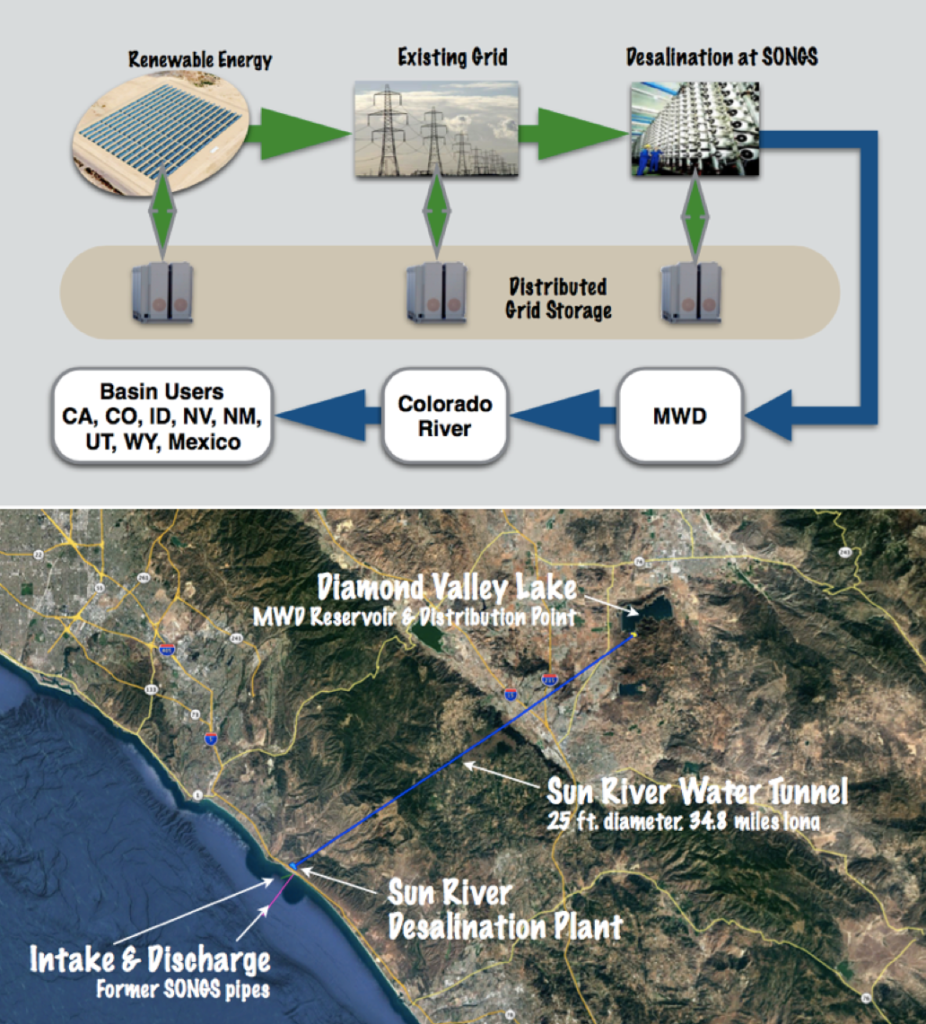 SAN CLEMENTE – SolRio Organization for Climate Change Mitigation Inc. has proposed a large-scale solar-powered desalination project at the decommissioned San Onofre Nuclear Generation Station.
SAN CLEMENTE – SolRio Organization for Climate Change Mitigation Inc. has proposed a large-scale solar-powered desalination project at the decommissioned San Onofre Nuclear Generation Station.
SunRiver has the potential to produce 1.1 billion gallons of potable water daily by utilizing water from the Pacific Ocean in an ecologically sensible manner. The project aims to reduce pressure on surface water resources and to create “drought-proof” watershed for the American Southwest.
SunRiver serves as an alternative plan to the California Water Fix and Eco Restore Project proposed by Governor Jerry Brown and the California Department of Water Resources. Where The CA Water Fix Project requires two large tunnels and risks the ecological health of the Sacramento-San Joaquin Delta, SunRiver only requires one tunnel and helps to preserve the vitality of the Colorado River.
The proposed SunRiver Project uses the existing seawater inlet and discharge pipes and high power grid connection at the decommissioned San Onofre Nuclear Generating Station (SONGS) on the Southern California coast.
Power to operate the SolRio Project will be generated by a combination of solar panels and grid storage batteries. The combined area of these solar plants is 39 square miles and 12 GWh of storage are used.
SunRiver includes construction of a 35-mile long water transport tunnel to deliver water from the desalination plant directly to Diamond Valley Lake, which acts as the storage and distribution point for the Southern California Metropolitan Water District (MWD). This new desalinated water can then be swapped for water MWD would otherwise draw from the Colorado River or the Central Valley.
The SunRiver Project incorporates technology to address the two major environmental issues seawater desalination typically presents: sea creature entrainment, and brine discharge.
SunRiver uses a fish separation and return device in the SONGS seawater inlet system to minimize impingement and entrainment of larger fish. Additionally, the plan employs wetland restoration to offset loss of smaller organisms entrained through the plant’s condensers.
Arrays of mixed nozzles on SunRiver’s discharge pipes infuse hot discharged water with cool water to lower the discharge temperature. The mixed nozzle arrays also help to reduce the brine content in the discharged water,
The SunRiver Project provides ‘water swaps’ which work to supply distant needs. Currently, 1.1 billion gallons of water are drained from the Colorado River every day to supply Southern California’s MWD. SunRiver would be able to produce 1.1 billion gallons of new, freshwater daily, which can be ‘swapped’ for the water that would otherwise be drained from the Colorado River.
Water swaps, falling costs of solar power, and use of existing infrastructure all work to reduce the overall costs of the SunRiver Project to an estimated total of $22.3 billion. Increasingly efficient desalination technology, ecological safeguards, and use of renewable energy allow SunRiver to provide an environmentally sustainable and “drought-proof” watershed to sustain growth and vitality of the American Southwest.
About SolRio: SolRio is a 501(c)(3) organization working towards solutions to combat drought and climate change in the American Southwest. SolRio’s vision embraces regional scale, solar-powered desalination to create a climate-proof watershed for continued ecological, social, and economic vitality. SolRio aims to produce new, clean, drinking water from seawater using the proven reverse osmosis (RO) process at a plant on the California coast. For more information, visit www.solrio.org. Find SolRio on Facebook, Twitter, and Instagram.
